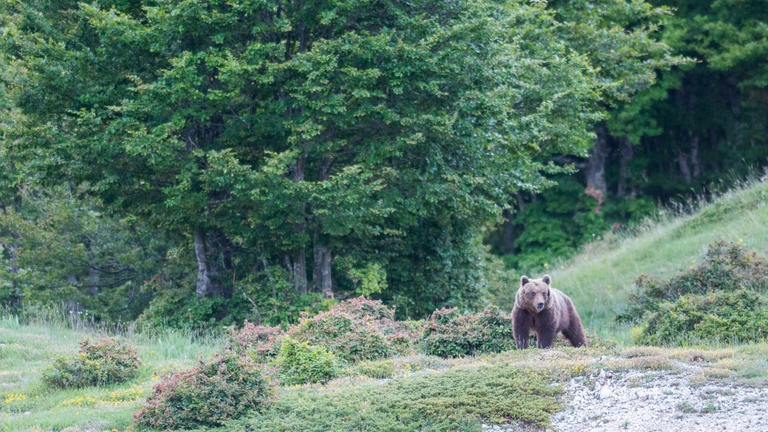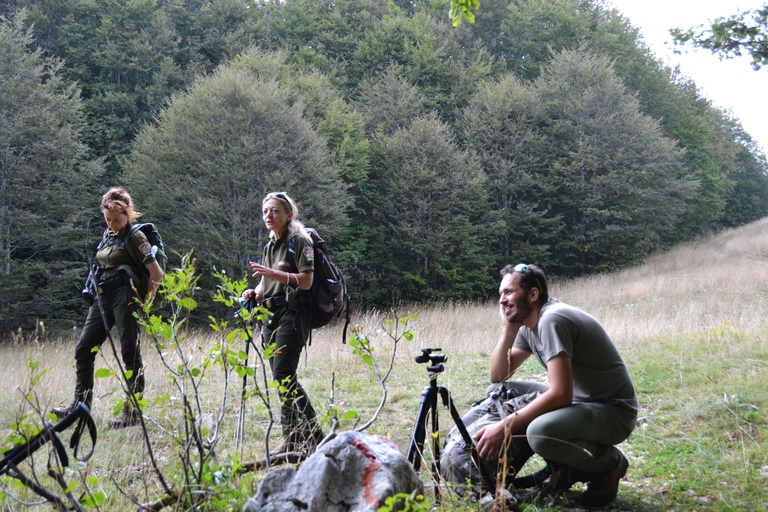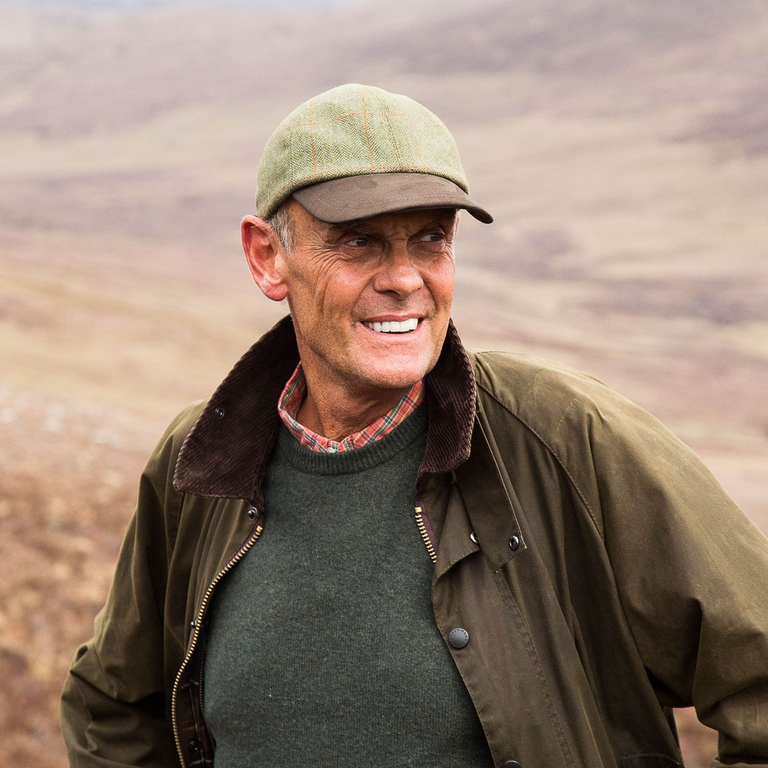
Canada’s wildfire season this year is impacting air quality way beyond the borders of the North American state, reaching as far as Europe.
From Scotland to Abruzzo, via Romania. Philanthropist Paul Lister’s mission is to save biodiversity, and the journey starts in Europe.
“I’m grateful for the history that has brought us where we are now, but the future belongs to nature and human beings have to learn to coexist with it”. Only then can real sustainable development be achieved. This, in essence, is Paul Lister‘s vision, which the Scottish environmentalist and philanthropist shared with us after a journey through central Italy’s Abruzzo, Lazio and Molise National Park.
Responsible tourism, in particular, plays a key role because it provides the opportunity to visit uncontaminated places and, at the same time, contribute to their protection by financing economic activities. Therefore, responsible travellers are strong allies to the agencies and institutions that work tirelessly, day after day, to protect these areas.
Lister founded The European Nature Trust (TENT) in 2000. He decided to devote part of his work to Abruzzo and its pride and joy, the Marsican brown bear, by supporting Italian association Salviamo l’Orso (Save the Bear), which works to protect the animal’s habitat.
What’s the story behind The European Nature Trust and what is it about?
There is a lot of wildlife in Africa, South America and South-East Asia. When I travelled to those places and then came back to Europe, I found that Europe was a very environmentally depleted continent. So much of the landscape has lost its original vegetation and the animals that go with it. So, when the time came, I decided to focus my interests close to home, rather than becoming one of those Europeans who point their finger against Brazilians, Kenyans and Indonesians.
I think we should spend more energy putting the spotlight on our remaining wild lands, and also encourage people to “rewild” (resisting the temptation to control nature, allowing it to find its own path by reintroducing lost plants and animals, according to George Monbiot, ed.). So while the landscape has become abandoned, with farms being abandoned as they become uneconomical, there is a great opportunity to rewild. With nature comes tourism, and added revenue for communities. In this way, people want to protect nature rather than threaten or deplete it. So that’s really why I’ve chosen to work in Europe.
Scotland, Romania, and Abruzzo: can you tell us about the projects promoted by TENT, and their objectives?
We also have two more countries, Spain and Belize, in the mix, although Belize is actually a tropical destination outside of Europe.
In Romania is the Foundation Conservation Carpathia (FCC). Romania is the most biodiverse country in Europe by far. It has 50 per cent of all the continent’s ancient forests. In the post-communist era, these forests have come under threat due to ruralisation, the timber mafia, and much else. So it’s important for Romanian people to put a value on their natural capital so they really understand how special their country is. We’re trying to establish a large, 250,000-hectare national park extending all the way from Sibiu to Brasov in the Făgăraș mountains. This can be achieved by buying a certain amount of land and then using that land as leverage against the authorities and governments to have more hectares added to it. It’s a concept that comes from Tompkins Conservation in Chile and Argentina. Ours is a huge project that has been running for 15 years now. We’re making excellent progress, so we’re thrilled about that.
In Britain, we estimate that 99 per cent of our original forests have gone. 99 per cent! In Scotland, we’ve planted one million trees, brought back red squirrels, dramatically reduced deer numbers, got involved with education programmes in local communities, and we have an eco-tourism business there. The long-term vision is to see wolves brought back into a 20,000-hectare fenced reserve. This project draws inspiration from a similar solution in South Africa, where the fence ensures animals remain in the protected area. I don’t believe we will ever get permission to release wolves into the wild in Scotland. There are too many sheep around, and there’s an ancient tradition of shepherds. Furthermore, there are too many motorways, fences and railroads. I think the best way forward in Scotland is to bring wolves back into a big protected area.
In Spain, we work with two foundations: one is in the north of the country and has to do with bears, Fundación Oso Pardo. In 25 years, they’ve increased northern Spain’s bear population from 25 to more than 300 bears. It has been a tremendously successful foundation, and we support them. Then, in the south, there’s CBD Habitat. They’re involved with the Iberian lynx (Lynx pardinus), a species of lynx different from what we have in other parts of Europe. 25 years ago, there were only 100 of these animals left, and now there are around 800.
In Belize, we work with protecting the scarlet macaw (Ara macao), a large type of parrot. We’re also producing a documentary. I think films are a good way to communicate and show people landscapes and the threats they face. We’re also involved in jaguar habituation, creating protected areas and stopping jaguar poaching. We’re trying to get the jaguars used to people’s vehicles so they don’t run away. Then we can create a new economy based around jaguar tourism, as has happened for the Pantanal cat (Leopardus colocolo braccatus) in Brazil.
During our trip to Abruzzo, one of the things we heard the most from people was that, when they come, they fall in love with the place. What is your love story with Abruzzo National Park?
I had always heard about Abruzzo, it had been on my mind for decades as wild bears roam free here, and not just a few of them. And I thought that if there are wild bears, then there must be a good ecosystem. However, the projects in Scotland and Romania were taking up a lot of my time, so I never really had the chance to work in Abruzzo. We were making documentaries – we made four in Romania – so my time was consumed. Then, at the right moment, I met Bruno De Amici and eventually Umberto (Esposito, the Wildlife Adventures guide who accompanied us on our journey, ed.), and visited Abruzzo.
And, of course, you can’t help but fall in love with the area, its landscapes, forests and wildlife, and with the people living in the village of Pescasseroli. And then there’s all the food and Italian hospitality. So it isn’t difficult to find Abruzzo a beautiful, wonderful living landscape. It’s a symbiotic partnership between wildlife, nature and humanity. It’s a good story, we need to see more of these stories where people allow nature to thrive. Without them, there’s a big problem. We need wild landscapes, we need bees, we need all of this. My love affair with Abruzzo is nothing like going to Rome or other cities. I don’t really have much interest in history, I’m more interested in the future. History has got us where we are today, which is a great place; so I’d rather worry about the present and future. Of course, we can still draw on history as a point of reference, but I’m not into historical cities so much. I’d rather be in a forest.
Abruzzo National Park will soon celebrate its 100th anniversary. What should the next steps be for one of Italy’s oldest national parks? What challenges lie ahead?
I think the future is for people to appreciate that these animals, particularly the bear, can become a big driver for sustainable tourism. Some think that people shouldn’t be allowed to go into protected areas. Well, that’s impossible in a country like Italy, with 65 million people. It’s simply not possible. People need to go walking and explore nature. I think that when they do this, they better understand how it all works and want to protect these places. So, over the next hundred years, we have to encourage people to come – in the right numbers, to be arranged with tourism operators. We have to allow the bears to migrate from one park to the next. When people who see there is a thriving economy in Abruzzo Park, neighbouring areas might think: “Wow, we want to be a part of a project like that”.
Do you think tourism and conservation can be combined successfully?
Yes, absolutely. I’m a big fan, I think conservation and nature tourism is a growing business. People are becoming curious. The more people go into nature and see these wild animals, the more they want to protect them. To give an example, 15-20 years ago there was a big sea eagle that was brought back to the west side of Scotland. And now, it has become a big tourist attraction. People jump in their cars and go there because they want to see these huge, beautiful eagles, with a wingspan that can surpass three metres. The same goes for wolves in Yellowstone (National Park in the United States, ed.). Since they brought the wolves back, revenues have increased by 40 million dollars a year.
What is the importance of working with local communities and organisations for conservation?
It’s always a communication problem. If you’re trying to save a species or a landscape and you don’t get local people interested, you won’t succeed. The important thing is to keep them informed and communicate with them about the vision, the end-goal. And when people in local communities understand the vision, they will be supportive. We’ve always worked like this in Scotland, collaborating with local schools. Now, however, we’ve decided that everybody, every adult in the community, should also come along and get involved.
When we were in Abruzzo, everyone had their own stories about encounters with bears. What is yours?
It was morning, quite cool, the sun was coming up and we were sitting having coffee. I think I was with Umberto, and Bruno was there too. All of a sudden, a bear started walking toward the hut where we were, and it stopped about 20 metres away. It just stopped, looked at us, and then started walking back down. So, you know, to get up in the morning, have a cup of coffee and the first thing you see is a Marsican bear, up in the high meadows: it’s such a wonderful and memorable experience. I haven’t had just one encounter with bears, but that was the most memorable.
Are you planning on going back to Abruzzo soon?
Oh yes, absolutely. We’re planning on making a film there in June, but due to Covid-19 restrictions, I suspect it won’t happen until May or June next year. I love just being in nature. I have a house in London and a small apartment in Miami but I’m selling both of them. I’m finished with the big cities. I like to be outside, and I can always pop into a city.
Siamo anche su WhatsApp. Segui il canale ufficiale LifeGate per restare aggiornata, aggiornato sulle ultime notizie e sulle nostre attività.
![]()
Quest'opera è distribuita con Licenza Creative Commons Attribuzione - Non commerciale - Non opere derivate 4.0 Internazionale.
Canada’s wildfire season this year is impacting air quality way beyond the borders of the North American state, reaching as far as Europe.
Two new studies have revealed that the retreat of the Thwaites Glacier is happening in a different, more complex way than previously understood.
A study of tissue samples from killer whales in Canada was the first to find a dangerous toxic chemical, known as 4NP, in the animals’ flesh.
The South African government is clamping down on the controversial multimillion-dollar lion-breeding industry, thanks to pressure from activists.
Switzerland’s glaciers are shrinking, with a new study finding that they have lost more than half their total volume since the early 1930s.
Santa Olalla, the last permanent lagoon in the park, has disappeared under the pressure of drought, overexploitation, and illegal wells.
Vulture populations in southern Asia experienced a 99% collapse and for a long time nobody knew why. Then, a historic discovery saved them.
The Indian government has pledged to reintroduce cheetahs, classified as a “vulnerable” species by the IUCN, into the wild. The animals will be transferred from Africa.
In Australia, more and more platypuses are getting caught in plastic waste. Efforts to protect this species need to be increased.










